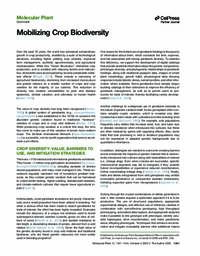Authors:
Susan McCouch
Zahra Katy Navabi, Michael Abberton, Noelle Anglin, Rosa Lia Barbieri, Michael Baum, Kirstin Bett, Helen Booker, Gerald L. Brown, Glenn J. Bryan, Luigi Cattivelli, David Charest, Kellye Eversole, Marcelo Freitas, Kioumars Ghamkhar, Dario Grattipaglia, Robert Henry, Maria Cleria Valadares Inglis, Tofazzal Islam, Zakaria Kehel, Paul Kersey, Graham J. King, Stephen Kresovich, Emily Marden, Sean Mayes, Marie Noelle Ndjiondjiop, Henry T. Nguyen, Samuel Rezende Paiva, Roberto Papa, Peter W.B. Phillips, Awais Rasheed, Christopher M Richards, Mathieu Rouard, Maria Jose Amstalden Sampaio, Uwe Scholz, Paul Shaw, Brad Sherman, S. Evan Staton, Nils Stein, Nils Stein, Jan Svensson, Mark Tester, Jose Francisco Montenegro Valls, Rajeev Varshney, Stephen Visscher, Eric J. B. von Wettberg, Robbie Waugh, Robbie Waugh, Peter Wenzl, Loren H. Rieseberg
Over the past 70 years, the world has witnessed extraordinary growth in crop productivity, enabled by a suite of technological advances, including higher yielding crop varieties, improved farm management, synthetic agrochemicals, and agricultural mechanization. While this “Green Revolution” intensified crop production, and is credited with reducing famine and malnutrition, its benefits were accompanied by several undesirable collateral effects (Pingali, 2012). These include a narrowing of agricultural biodiversity, stemming from increased monoculture and greater reliance on a smaller number of crops and crop varieties for the majority of our calories. This reduction in diversity has created vulnerabilities to pest and disease epidemics, climate variation, and ultimately to human health (Harlan, 1972).
The value of crop diversity has long been recognized (Vavilov, 1992). A global system of genebanks (e.g., www.genebanks.org/genebanks/) was established in the 1970s to conserve the abundant genetic variation found in traditional “landrace” varieties of crops and in crop wild relatives (Harlan, 1972). While preserving crop variation is a critical first step, the time has come to make use of this variation to breed more resilient crops. The DivSeek International Network (https://divseekintl.org/) is a scientific, not-for-profit organization that aims to accelerate such efforts.
Citation:
Susan McCouch, Zahra Katy Navabi, Michael Abberton, Noelle Anglin, Rosa Lia Barbieri, Michael Baum, Kirstin Bett, Helen Booker, Gerald L. Brown, Glenn J. Bryan, Luigi Cattivelli, David Charest, Kellye Eversole, Marcelo Freitas, Kioumars Ghamkhar, Dario Grattipaglia, Robert Henry, Maria Cleria Valadares Inglis, Tofazzal Islam, Zakaria Kehel, Paul Kersey, Graham J. King, Stephen Kresovich, Emily Marden, Sean Mayes, Marie Noelle Ndjiondjiop, Henry T. Nguyen, Samuel Rezende Paiva, Roberto Papa, Peter W. B. Phillips, Awais Rasheed, Christopher M Richards, Mathieu Rouard, Maria Jose Amstalden Sampaio, Uwe Scholz, Paul Shaw, Brad Sherman, S. Evan Staton, Nils Stein, Jan Svensson, Mark Tester, Jose Francisco Montenegro Valls, Rajeev Varshney, Stephen Visscher, Eric J. B. von Wettberg, Robbie Waugh, Peter Wenzl, Loren H. Rieseberg. (5/10/2020). Mobilizing Crop Biodiversity. Molecular plant, 13 (10), pp. 1341-1344.

